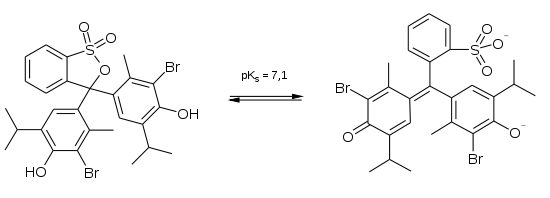Bromothymol blue
| Bromothymol blue | |
|---|---|
 | |
 | |
| IUPAC name 4,4'-(1,1-dioxido-3H-2,1-benzoxathiole-3,3-diyl)bis(2-bromo-6-isopropyl-3-methylphenol) | |
| Identifiers | |
| CAS number | 76-59-5 |
| PubChem | 6450 |
| ChemSpider | 6208 |
| UNII | VGU4LM0H96 |
| Jmol-3D images | Image 1 |
| |
| |
| Properties | |
| Molecular formula | C27H28Br2O5S |
| Molar mass | 624.38 g mol−1 |
| Density | 1.25 g/cm3 |
| Melting point | 202 °C; 396 °F; 475 K |
| Acidity (pKa) | 7.10 |
| Hazards | |
| MSDS | External MSDS |
| NFPA 704 |
 1
2
0
|
| Supplementary data page | |
| Structure and properties |
n, εr, etc. |
| Thermodynamic data |
Phase behaviour Solid, liquid, gas |
| Spectral data | UV, IR, NMR, MS |
| Except where noted otherwise, data are given for materials in their standard state (at 25 °C (77 °F), 100 kPa) | |
| Infobox references | |
Bromothymol blue (also known as bromothymol sulfone phthalein, Bromthymol Blue, and BTB) is a pH indicator for weak acids and bases. It is mostly used in applications that require measuring substances that would have a relatively neutral pH (near 7), such as managing the pH of pools and fish tanks. A common use is for measuring the presence of carbonic acid in a liquid. It is typically sold in solid form as the sodium salt of the acid indicator.
| Bromothymol Blue (pH indicator) | ||
| below pH 6.0 | above pH 7.6 | |
| 6.0 | ↔ | 7.6 |
Properties
Bromothymol blue acts as a weak acid in solution. It can thus be in protonated or deprotonated form, appearing yellow or blue respectively. It is bluish green in neutral solution. The deprotonation of the neutral form results in a highly conjugated structure, accounting for the difference in color.

Bromothymol blue is sparingly soluble in water, but soluble in alcohol, ether and in aqueous solutions of alkalis. It is less soluble in non-polar solvents such as benzene, toluene and xylene, and practically insoluble in petroleum ether.[1]
Preparation
To prepare a solution for use as pH indicator, dissolve 0.10g in 8.0 cm3 N/50 NaOH and dilute with water to 250 cm3. To prepare a solution for use as indicator in volumetric work, dissolve 0.1g in 100 cm3 of 50% (v/v) ethanol.[1]
Uses

Bromothymol blue may be used for observing photosynthetic activities, or as a respiratory indicator (turns yellow as CO2 is added).[2][3] A common demonstration of BTB's pH indicator properties involves exhaling through a tube into a neutral solution of BTB. As carbon dioxide is absorbed from the breath into the solution, forming carbonic acid, the solution changes color from green to yellow. Thus, BTB is commonly used in science classes to demonstrate that the more that muscles are used, the greater the CO2 output.
It may also be used in the laboratory as a biological slide stain. At this point it is already blue, and a drop or two is used on a water slide. The cover slip is placed on top of the water droplet and the specimen in it, with the blue coloring mixed in. It is sometimes used to define cell walls or nuclei under the microscope.
Bromothymol is used in obstetrics for detecting premature rupture of membranes. Amniotic fluid typically has a pH > 7.2, bromothymol will therefore turn blue when brought in contact with fluid leaking from the amnion. As vaginal pH normally is acidic, the blue color indicates the presence of amniotic fluid. The test may be false-positive in the presence of other alkaline substances such as blood, semen, or in the presence of bacterial vaginosis.
See also
References
- ↑ 1.0 1.1 O'Neil, Maryadele J (2006). The Merck Index. Merck Research Laboratory. p. 1445. ISBN 978-0-911910-00-1.
- ↑ Sabnis R. W. (2007). Handbook of Acid-Base Indicators. CRC Press. ISBN 0-8493-8218-1.
- ↑ Sabnis R. W. (2010). Handbook of Biological Dyes and Stains: Synthesis and Industrial Applications (1st ed.). Wiley. ISBN 0-470-40753-0.